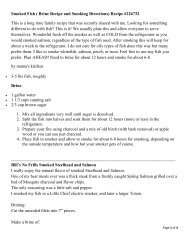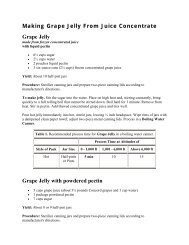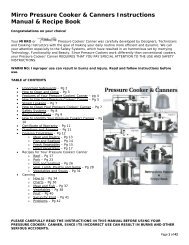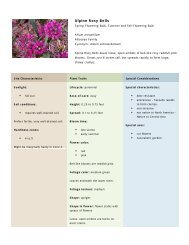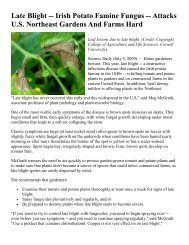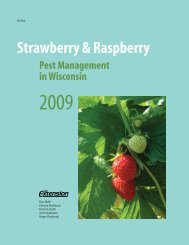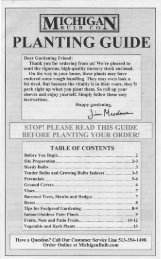Growing Blackberries in Your Home Garden, EC 1303 (Oregon ...
Growing Blackberries in Your Home Garden, EC 1303 (Oregon ...
Growing Blackberries in Your Home Garden, EC 1303 (Oregon ...
- No tags were found...
Create successful ePaper yourself
Turn your PDF publications into a flip-book with our unique Google optimized e-Paper software.
primocane-fruiter for only the primocane crop.If you want fruit <strong>in</strong> July, it is best to grow afloricane-fruit<strong>in</strong>g erect (e.g., ‘Navaho’) or trail<strong>in</strong>gblackberry (e.g., ‘Marion’ or ‘Boysen’). Thesetypes produce better quality fruit and a higheryield than the floricane crop of primocane-fruit<strong>in</strong>gblackberries.To grow primocane-fruit<strong>in</strong>g blackberries foronly a primocane crop, cut all the canes off to justabove ground level <strong>in</strong> late w<strong>in</strong>ter. When the newprimocanes are 3 1 ⁄2 feet tall, remove about 6 <strong>in</strong>chesof the tip. The branches produced will flower andfruit <strong>in</strong> the fall. A summer-pruned primocane willproduce more than three times the yield of anuntipped primocane.Canes may benefit from a temporary trellis.Semierect blackberriesSemierect blackberries also require summerprun<strong>in</strong>g. When primocanes are just over 5 feet tall,remove the top 2 <strong>in</strong>ches of the tip to encourage theproduction of lateral branches. Check the plant<strong>in</strong>gseveral times, and tip all of the primocanes as theygrow.In w<strong>in</strong>ter, first remove the dead floricanes.Tra<strong>in</strong> the rema<strong>in</strong><strong>in</strong>g primocanes to the double “T”trellis (Figure 5). The branches do not need to beshortened. However, if they are too vigorous andare difficult to tra<strong>in</strong>, they can be shortened <strong>in</strong> latew<strong>in</strong>ter.HarvestPick berries every 4 to 7 days, depend<strong>in</strong>g onweather and cultivar. Regular pick<strong>in</strong>g m<strong>in</strong>imizesproblems with disease and <strong>in</strong>sect pests that likeoverripe, rott<strong>in</strong>g fruit. When the berries are ripe,you can pick them quite easily. Use a break<strong>in</strong>g,rather than pull<strong>in</strong>g, motion. Pick <strong>in</strong>to a shallowconta<strong>in</strong>er to prevent fruit from crush<strong>in</strong>g.To extend shelf life, avoid pick<strong>in</strong>g when berriesare wet, and refrigerate as soon as possible.Expect yields of 10 to 13 lb/plant <strong>in</strong> trail<strong>in</strong>gblackberry cultivars, 4 to 6 lb/plant <strong>in</strong> erect types,and 25 to 55 lb/plant <strong>in</strong> semierect types.Boysen.Figure 5. Semierect blackberry (‘Chester’) tra<strong>in</strong>ed to adouble “T” trellis.7




